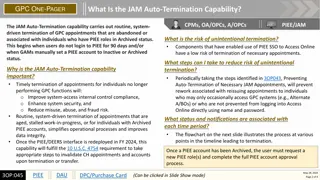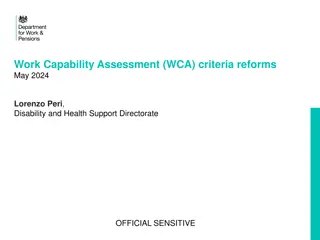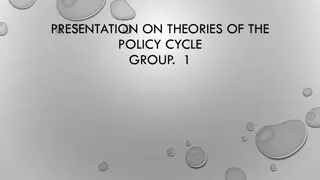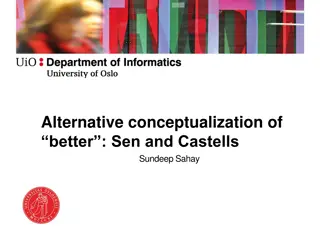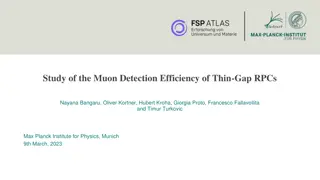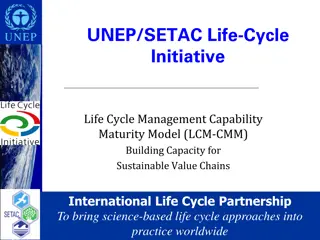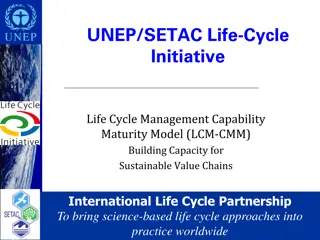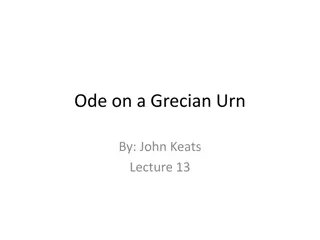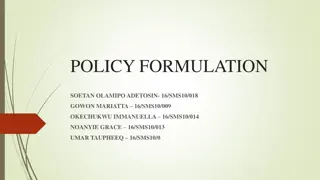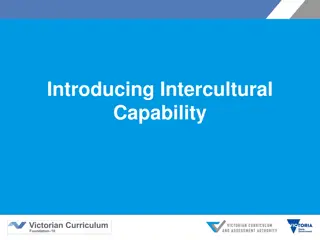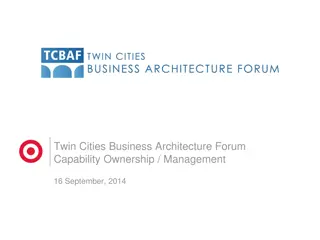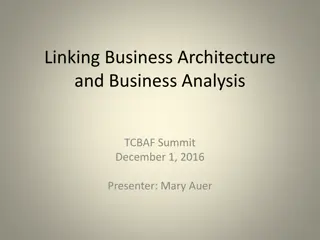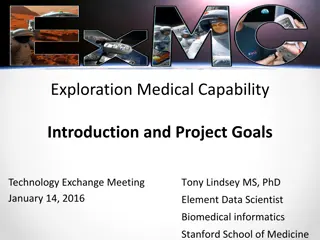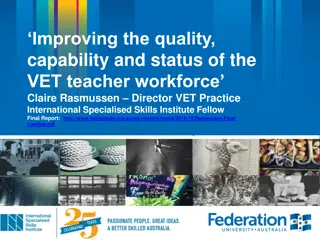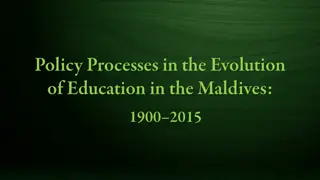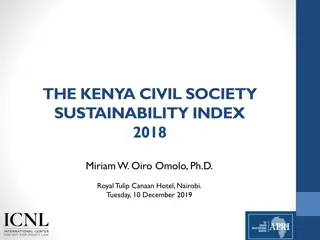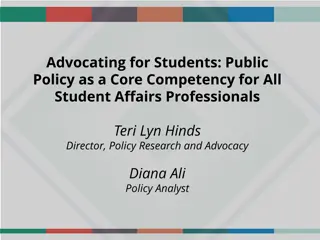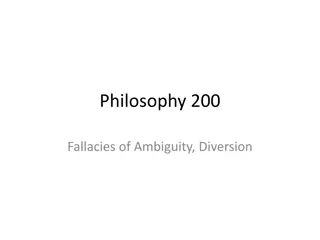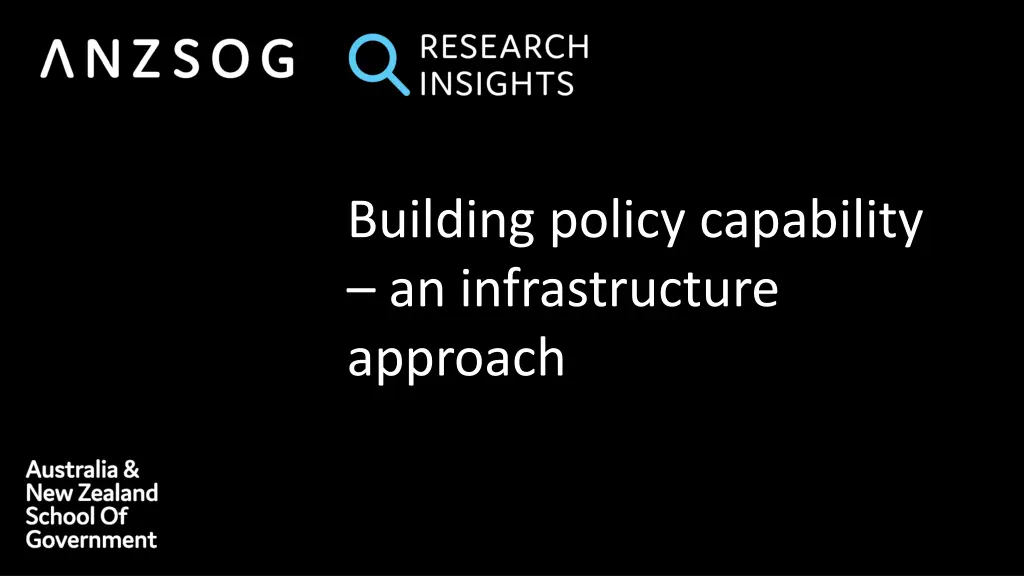
Enhancing Policy Capability: Insights and Strategies
Explore insights and strategies for enhancing policy capability with a systemic approach. Learn about initiatives from education departments across different jurisdictions and how they are addressing common challenges in policy advisory systems. Discover the importance of building policy capability infrastructure for effective policy development and collaboration.
Download Presentation

Please find below an Image/Link to download the presentation.
The content on the website is provided AS IS for your information and personal use only. It may not be sold, licensed, or shared on other websites without obtaining consent from the author. If you encounter any issues during the download, it is possible that the publisher has removed the file from their server.
You are allowed to download the files provided on this website for personal or commercial use, subject to the condition that they are used lawfully. All files are the property of their respective owners.
The content on the website is provided AS IS for your information and personal use only. It may not be sold, licensed, or shared on other websites without obtaining consent from the author.
E N D
Presentation Transcript
Building policy capability an infrastructure approach
BUILDING POLICY CAPABILITY Insights from a 'curated conversation' between Education departments from three jurisdictions. March, 2022 ANZSOG.EDU.AU @ANZSOG
Building Policy Capability BACKGROUND AND INTENT Many organisations and jurisdictions recognise their policy advisory systems need improving. They report remarkably similar challenges, including concerns about the quality of policy advice, shortages of skilled senior policy advisors, a lack of investment in future capability, and weak systems for collaboration, alignment and prioritisation. However, they have taken different approaches to addressing those weaknesses. The policy capability infrastructure* Building policy capability requires a systemic approach. ANZSOG refers to this as developing an effective policy infrastructure . This infrastructure involves committed leadership, action to strengthen and align policy development systems and processes, effective frameworks, tools, and guidance to support policy professions in their work, and targeted skills development. It means focusing on both the supply and demand side of the policy equation. ANZSOG works with a range of organisations and jurisdictions to support them to improve their policy advisory systems. Serendipitously, education departments feature in that current group of organisations. ANZSOG decided to convene a curated conversation to bring together senior officials from three of those departments: the South Australian Department for Education, The Ministry of Education in Aotearoa New Zealand and the Australian Government Department of Education, Skills and Employment. The conversation was designed to provide an opportunity for those organisations to share lessons and approaches to improving policy capability as well as fostering ongoing inter-jurisdictional relationships. The focus was on policy capability rather than education policy, but the education domain provided a useful common context. * The policy capability infrastructure draws on the NZ Policy Capability Framework. It is used in a range of ANZSOG s teaching and advisory offerings. ANZSOG.EDU.AU @ANZSOG
Building Policy Capability PARTICIPANTS AND PROCESS Participants were chosen by each jurisdiction in direct speaking roles. Additional colleagues from each jurisdiction attended as observers. The session was held under Chatham House Rule (quotations are not attributed). Sally Washington, ANZSOG Executive Director for Aotearoa New Zealand, facilitated the session and Subho Banerjee, ANZSOG Deputy CEO acted as keynote listener to draw out insights at the end. Organisation Contributors Each jurisdiction has initiatives to enhance policy capability in their agency. Each has some connection to ANZSOG, and some transfer of ideas and frameworks between jurisdictions is already occurring. Australian Government Department of Education, Skills and Employment Dom English, First Assistant Secretary, Higher Education Division The South Australian Department for Education has recently written a case study describing its Strategic Policy Model and processes for building policy capability. The case study was published by ANZSOG and has generated considerable interest from other organisations and jurisdictions. The Strategic Policy Model and related policy skills framework drew on collateral from New Zealand s Policy Project a program to improve policy quality and capability across the NZ public service. New Zealand Government Ministry of Education, Te T huhu o te M tauranga Andy Jackson, Deputy Secretary, Policy Julie Keenan, Policy Director The New Zealand Ministry of Education, Te T huhu o te M tauranga, is redesigning its policy function to support wider organisational changes, set out in a summary document . It is working to enhance its overall policy capability including to honour Te Tiriti o Waitangi and to integrate its advice across education sectors and with front-line and local insights. Peta Smith, Executive Director Strategic Policy and External Relations Luke Fraser, Director, Governmental Relations and Policy South Australian Government Department for Education The Australian Department of Education, Skills and Employment is working with ANZSOG on a range of staff development activities to strengthen its strategic policy capability and skills, including with respect to policy project planning, stakeholder analysis, problem definition and strategic analysis tools. Sally Washington, Executive Director, Aotearoa New Zealand (facilitator) Subho Banerjee, Deputy CEO, Research and Advisory (keynote listener) The Australia and New Zealand School of Government ANZSOG.EDU.AU @ANZSOG
Building Policy Capability CONVERSATION THEMES The conversation allowed senior leaders to hear from each other about strategies and approaches for building policy capability, and to compare different perspectives on what success would look like. The curated conversation was designed to explore the following questions: is driving the need for change and how can other reform goals be leveraged and supported by policy improvement initiatives? context and driversfor policy capability improvement initiatives. What Session format Theme 1: The Imperative What are we trying to achieve and why? Context and drivers. new ways of working and what are the key roles and relationships that need to be built and maintained? processes and stakeholders. Who is involved in designing and leading needed to support policy staff in their day-to-day work, and to ensure consistency of approach without constraining innovation and agility? frameworks and tools to support policy professionals. What collateral is Theme 2: Actions towards improvement How are we going about building capability? What are we focusing on? modern policy professionals and what sort of development and training works best to build those skills? approaches to upskilling policy professionals. What skills are required of Theme 3: Catalysing change and making it stick How do we get there? What are the critical success factors for a successful change process? learn from each other about successful operating models for ensuring change is catalysed and sticks? critical success factors for implementing a change process. What can we Reflections: Insights and lessons to share These were distilled into three themes. What follows is a pr cis of the conversation, to draw out key transferable insights. ANZSOG.EDU.AU @ANZSOG
THEME 1 THE IMPERATIVE Context and driversfor policy capability improvement initiatives. What are we trying to achieve and why? Each jurisdiction is on a quest to improve policy capability - in order to produce high-quality policy advice to support good government decision-making. But they work in different contexts; there are similarities and differences in their approaches. Key insights: Change can provide an opportunity for more change...and improvement New leadership, organisational change or other reform initiatives can provide an opportunity and potential leverage for improvement initiatives. These can form part of a narrative of creating new norms or ways of doing things to further catalyse and affect improvements in policy capability and processes. Politics or political considerations are sometimes seen as limiting policy options (and effectiveness), especially attempts to focus on longer-term policy challenges. A focus on stewardship, including being proactive in advice to ministers and government, can help to enhance this political administrative relationship. We need to find ways to have conversations with ministers, and other senior leaders, to enable the capability shifts needed to achieve long-term complex policy goals. Jurisdictional and system drivers present challenges for organisations The quality of policy advice and guidance on policy processes is often inconsistent, even within an organisation. Agreeing and articulating repeatable and scalable processes is important for ensuring consistently high-performance and for improving overall capability. Major system-level reforms require consistency across an organisation and even across other organisations in a jurisdiction (especially where policy is cross-cutting). Building trust between government agencies and clients (both providers and end-users) is a system level concern and requires reconfiguring and building relationships and trust between agencies and internal and external stakeholders. Policy needs to be informed by knowledge and practice in the field. Understanding connections and interdependencies is crucial for building a joined-up system. You need to understand the system to improve the system. First Nations rights and interests, are a key concern in thinking through system level change. In the case of Aotearoa New Zealand, Te Tiriti o Waitangi (Te Tiriti / the Treaty of Waitangi) underpins those relationships and desired policy outcomes. Established policy tools need to better reflect and support evolving understandings of Te Tiriti. Differential impacts of policy need to be analysed and equity considerations in relation to First Peoples need to be built into policy goals in all jurisdictions. ANZSOG.EDU.AU @ANZSOG
Building Policy Capability THEME 2: ACTIONS TOWARDS IMPROVEMENT How are we going about building capability? What are we focusing on? Participating organisations are at different points in their policy improvement journeys. They are taking different paths. For some, the primary focus is on a consistent model for policy design and delivery; for others the focus is on building the professional capability or the policy skills of staff. All agreed that regardless of the approach taken, it needs to be deliberate, well-articulated and effectively communicated across the organisation. Key insights: Build a shared view of current practice Being clear about the current state is an important starting point. Sometimes it is helpful to hold a mirror up to ourselves (including by inviting outside critique) to understand the challenge, identify the pain points , and to catalyse and guide action towards improvement. Process mapping or mapping the wider system can surface complex and important interrelationships. Agencies have different approaches to articulating, and evaluating, the quality of their policy advice. This is an area with potential to better measure current performance and future performance improvement. There are opportunities to leverage, adapt or adopt, established models (frameworks and tools) from elsewhere (e.g. NZ agencies must report policy quality scores annually against the Policy Project Policy Quality framework). First articulate capability domains, then focus development efforts and exemplify good practice Articulating a clear, relevant capability model (e.g. the South Australian Department for Education Strategic Policy Model) provides scaffolding for shared language and understanding good practice. Examples of successful applications of the model to policy challenges help to socialise use of the model and reinforce its future use. A model of the policy process can also focus staff development efforts (both formal and on-the-job learning). ANZSOG.EDU.AU @ANZSOG .
Building Policy Capability THEME 2: ACTIONS TOWARDS IMPROVEMENT (CONTINUED) Tools are vital, but they need to be useful and used , and supported by the culture Building easy to understand collateral and tools that are accessible, easy to use, and help policy practitioners in their day-to-day work is a key part of the policy improvement equation. The challenge is to ensure consistency across the organisation without constraining innovation and agility. Use of tools and frameworks need to be championed by management and leadership as the way we do things around here . They need to become part of the culture. Appoint and equip internal champions as enablers to work with teams across the agency Internal champions can help teams solve their business problems while simultaneously demonstrating the value of new tools and models. These champions can operate along the lines of an internal consulting model or be embedded in teams working on substantive policy challenges. Experimentation with different operating models will generate insights for a sustainable ongoing support function. Policy skills frameworks can articulate the skills required now, and in future, for high- performing policy practitioners and teams. Skills frameworks provide the architecture to articulate what is required of modern policy professionals (including areas not usually well described like political nous or strategic thinking skills). They can signal where and why new capabilities are needed (such as in data and analytics, collaboration, strategic foresight, participatory methods) and how these can be mapped for individuals, teams and organisations. There are existing models that can be drawn on. For example, the South Australian Department for Education has adapted the New Zealand Policy Skills Framework. NZ Policy Skills Framework ANZSOG.EDU.AU @ANZSOG
Building Policy Capability THEME 2: ACTIONS TOWARDS IMPROVEMENT (CONTINUED) Recognise policy skills across the policy value chain and value diversity Articulating policy skills surfaces the role and value of policy work and the interface with other functional groups (delivery, communications, legal etc,) that are part of the policy value chain. It can help other non-policy staff see where they fit, and where their skills are relevant to policy work. Even those working in policy roles don t always identify as policy professionals. Recruiting for good policy analysis and policy related skills is central but there is an increasing interest in seeking out innovative thinkers - to bring new ideas and ways of working - who are able to relate to different audiences and contexts. Building overall people capability means building baseline skills across the team or organisation while creating the space for diversity (in all its forms, including diversity of thought). Build people capability according to team, organisation and system needs Efforts to build policy skills work best when they are deliberate and based on the needs of the team or organisation (as opposed to ad hoc and driven by individuals personal development interests). Professional development works well as a team sport. The Higher Education Division of the Australian Department of Education, Skills and Employment has a comprehensive program to develop the collective strategic policy skills of the division. It is also recruiting more staff at junior levels. A structured training program across any organisation needs to enable staff at all levels of responsibility to improve their policy practice, from foundational training for junior career levels to bespoke programs for senior staff. It is a case of continuous improvement. You never finish this work! Whether to buy or grow policy staff, and in what ratios, is an important consideration across organisations. Agencies investing in their staff development should view this as a wider investment in system wide capability, acknowledging and accepting that skills are shared and circulate between agencies as staff move around the public service. Turnover is not a zero-sum game. Leaders have a responsibility for building and maintaining a sense of purpose and identity within an organisation while promoting the importance of overall system performance. South Australian Department for Education policy skills framework ANZSOG.EDU.AU @ANZSOG
Building Policy Capability THEME 3: CATALYSING CHANGE AND MAKING IT STICK How do we get there? What are the critical success factors for a successful change process? Participants shared their insights about how to catalyse and maintain an improvement programme. All agreed that connecting-up the pieces of the policy improvement puzzle is important for sustainable reform. Improvement initiatives that are mutually reinforcing add up to more significant and longer-lasting change. Mutually reinforcing initiatives drive transformative change An incremental approach is useful, but we need to set ourselves up with a policy capability approach where the initiatives are mutually reinforcing and part of a deliberate change process This needs all the elements aligned and moving in the same direction : professional development and training, career trajectories, organisational structures and processes, and supporting management and leadership. You need all of these things firing at once . A deliberate operating model? An agency s operating model - its ways of working - can often be implicit: Not thinking you have an operating model is an operating model! Being explicit about how to manage the change process and how you will work with others is important. We can learn from each other about successful operating models or what works for ensuring change is catalysed, supported and sticks. Collaboration and stakeholders building relationship capital and coalitions of the willing It is important to think about who is involved in designing and leading new ways of working and what are the key roles and relationships that need to be built and maintained. This means asking, Who do we want to work with? , identifying committed leaders and fellow travellers , and developing a targeted engagement strategy. It means building coalitions of the willing . It also means checking in with stakeholders to ensure the direction of travel is still valid and making headway. Top-down approaches are less successful than collaborative change processes. ANZSOG.EDU.AU @ANZSOG
Building Policy Capability THEME 3: CATALYSING CHANGE AND MAKING IT STICK (CONTINUED) Encourage review and constructive challenge to derive lessons learned . the leadership team should support a process of regularly questioning how things are going and build those insights into ongoing improvement initiatives. Keep plugging away at what worked and what didn t . Engaging external analysis or review can be useful for providing an arm's length perspective. This can yield a justification for change by helping make explicit what is sometimes assumed or obscured by internal staff who can sometimes be too close to the action or wedded to particular initiatives. Beware of groupthink. Leadership needs to sponsor, champion and enable purposeful change Building a clear sense of purpose and direction through continuous and joined up discussion is vital. This can require the leadership group to convene regularly (one participant suggested daily check-ins)to discuss process and progress. Leadership needs to be present and connected at all levels to build intra and inter agency knowledge. If senior leaders don t take this seriously.... accountability and enthusiasm [for change] is compromised . ANZSOG.EDU.AU @ANZSOG
Building Policy Capability REFLECTIONS: INSIGHTS AND LESSONS TO SHARE Highlights and key insights from the session: Shared ambition and variations in experience and approach can drive learning A high degree of ambition for this agenda across jurisdictions is impressive. All of the participants aspire to excellence. The variations in approach and stage of journey across jurisdictions provide a basis for dialogue that can drive insight and shared learning. These lessons will be useful for other organisations, in other sectors, in other jurisdictions. A structured focus on the policy infrastructure can deepen our understanding of public administration in relation to delivering quality policy advice and supporting good government decision-making There are many interdependencies between the parts of policy infrastructure, and between the policy infrastructure and broader elements of the machinery of government and the wider public administration system. Conceptualising it all together as interconnected systems working to build public value is useful. this conversation gives me hope I have confidence that the children and young people living and learning in the jurisdictions represented today are in expert hands Frameworks and codification can help to make change stick Robust frameworks are needed for taking things to scale and for ensuring new ways of working are embedded and stick across an agency. A supportive underpinning culture and enabling leadership are vital. How to sequence change requires more discussion. An interesting future conversation could centre on how to coordinate change (bringing together and sharing existing good practice), where to lead (developing new bespoke collateral), and how to measure and show the results of improvement initiatives. Consistency and innovation can co-exist and be mutually reinforcing. Codifying good practice can lift capability to a commonly high standard. But it is important that this benchmark does not become the lowest common denominator over time. There is a need to ensure the agility, autonomy and culture to support innovation and experimentation. In this way, excellence and innovation can be mutually reinforcing. ANZSOG.EDU.AU @ANZSOG


